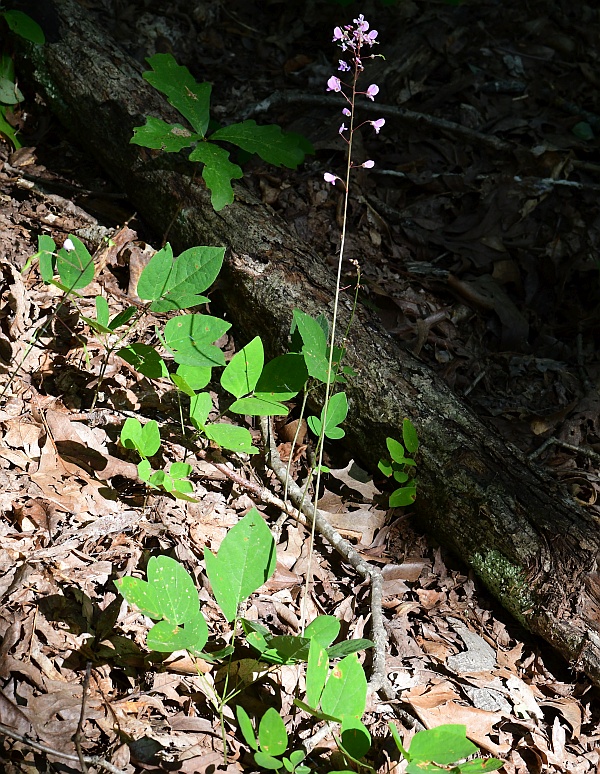Hylodesmum nudiflorum (L.) H. Ohashi & R.R. Mill
Naked Tick Trefoil

Native
CC = 4
CW = 5
MOC = 67
© SRTurner
Hylodesmum nudiflorum (L.) H. Ohashi & R.R. MillNaked Tick Trefoil | |
 |
Native CC = 4 CW = 5 MOC = 67 |
© SRTurner |
|
Family - Fabaceae/Faboideae Habit - Perennial forb with a short, sometimes woody rootstock, often taprooted, at least when young. Stems - Solitary but usually appearing paired, to 50 cm long, erect or ascending, in fertile plants with usually 1 flowering branch from just above or just below ground level, otherwise unbranched, this ascending to somewhat arched, usually overtopping the vegetative portion of the stem, usually leafless. Median portion of both types moderately to densely pubescent with minute, mostly hooked hairs and sparse to moderate, longer, straight, spreading hairs, both hair types usually sparser toward the stem base and denser toward the tip, the fertile branch occasionally nearly glabrous throughout. Vegetative stem to 20 cm tall.
Leaves - Clustered at the tip of the vegetative stem in an apparent whorl, pinnately trifoliolate, petiolate. One or more widely spaced, alternate leaves often present below the stem tip. Petioles 2-10 cm long. Stipules 2-4 mm long, 0.1-0.2 mm wide, at maturity olive green and appressed, mostly shed before flowering. Leaflets with the undersurface lighter than the upper surface and often somewhat glaucous; the central leaflet 3.0-8.5 cm long and 2-6 cm wide, rhombic, broadly elliptic, ovate, or obovate, angled or tapered to a sharply pointed tip; lateral leaflets 2.0- 6.5 cm long and 1.5-4.0 cm wide, somewhat asymmetrically ovate (the basal side broader than the side adjacent to the central leaflet).
Inflorescence - Inflorescences solitary, terminal on the fertile branch, erect or arched, unbranched or less commonly with few, spreading branches, the axis variously glabrous or sparsely to moderately pubescent with minute, hooked hairs and occasionally also with very sparse, straight, spreading hairs. Bracts 3-5 mm long, 0.5-0.8 mm wide, linear to narrowly lanceolate- triangular, mostly shed early; bractlets often also present, these very short (to 1 mm long), shed early. Flower stalks 8-20 mm long.
Flowers - Calyces green, nearly glabrous except for glandular hairs near the base and a few straight hairs on the lobes, the tube 1.5-2.0 mm long, the lobes 0.5- 1.0 mm long. Corollas papilionaceous, 5-9 mm long, pink or rarely white, the banner white near the clawed base, with a pair of slightly confluent, dark purple spots (nectar guides) above the base, the keel petals fused together. Stamens monodelphous, glabrous, 7 mm long. Ovary green, tuberculate, 5 mm long. Style white, 2-3 mm long. Calyx tube to 1 mm long, campanulate, with red spotting at base, sparse pubescent, shallowly 5-lobed. Lobes unequal, spreading in fruit, lowermost acute.
Fruits - Loments, nearly straight or arched downward, tapered abruptly to a stalklike base 8-18 mm long, consisting of 1-4 segments, each 7-9 mm long and 4-5 mm wide, the upper side of each segment sometimes very slightly concave, puberulent.
Flowering - June - August. Habitat - Mesic to dry upland forests, ledges of bluffs, edges of glades, and margins of sinkhole ponds, typically in acidic soils. Origin - Native to the U.S. Lookalikes - Numerous species of Desmodium. Other info. - Many plants in this group can be difficult to identify, but this is one of the exceptions. Unlike the others, this one separates its inflorescence from the leafy stem, such that the inflorescence appears to emerge directly from the ground. Occasionally, plants may be found with one or more leaves on the fertile shoot, and these have been labeled f. foliolatum (this has also been called a variety). The plant occurs throughout most of Missouri, with the exception of the northwestern quadrant and the Bootheel. Beyond Missouri it occurs throughout most of the eastern U.S. Photographs taken in Brown Summit, NC., 7-13-02 (DETenaglia); also at Meramec Conservation Area, Franklin County, MO, 7-22-2025 (SRTurner). |